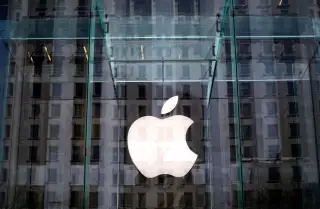The Real Reason Apple Split Its Stock

No, Apple's stock didn't crash over the weekend.
While the tech giant's shares — which had been trading at more than $650 a piece late Friday — are down to around $92 today, this was all part of Apple's planned 7-for-1 stock split, which went into effect Monday morning.
The company's official line for why it decided on such an unconventional split: "We want Apple stock to be more accessible to a larger number of investors."
But you don't have to be a genius to figure out why Apple chose to split each existing share into seven pieces as opposed to, say, the typical two. If Apple had split two for one, each share would still trade for around $325 apiece, making it highly unlikely that the committee that oversees the makeup of the Dow Jones industrial average — which includes the editor of The Wall Street Journal — would consider Apple for inclusion in the world's most well-known market benchmark.
Why? The Dow, unlike the S&P 500 or the Nasdaq composite, is a so-called price-weighted index. That means that the higher a company's share price is, the greater sway it will have on influencing movements in that index. (In a traditional market-capitalization weighted index, it is a company's overall value that determines its influence over the benchmark.)
At $325 a pop, Apple would still have accounted for nearly 15% of the Dow's movements, when no single stock today comes even close to playing a double-digit role in the benchmark. At $92, however, Apple's shares would fall to around 4% of the Dow, which would still make it one of the index's most influential stocks, but not disproportionately so. (Of course, the price of a stock matters little in reality without knowing how many shares of that company are outstanding.)
It's easy to understand why the Dow would want to include Apple. Not only is it the country's biggest company by market capitalization, it's also one of the world's most influential and recognized brands. Plus, the Dow currently only has about an 11% weighting in technology, versus 19% for the S&P 500, which is considered a far more accurate reflection of the broad economy.
RELATED FROM FORTUNE: The one Apple number that should scare investors
On the other hand, you might wonder why one of the market's hottest big stocks in recent years would want anything to do with the stodgy Dow. History shows that fast-growing stocks have a habit of slowing down once they get included in the index, as was the case with shares of Microsoft and Intel after both were put in the Dow on Nov. 1, 1999:
For Apple, this may be a not-so-tacit acknowledgment that the company has reached a new phase in its life-cycle -- one marked by maturity and stability, but slower growth.
Microsoft went through something similar 15 years ago. Note below how Microsoft's earnings growth rate started to falter just before the stock was included in the Dow in late 1999:
MSFT Gross Profit (3 Year Growth) data by YCharts
And here's what Apple's profit growth rate has looked like recently:
AAPL Gross Profit (3 Year Growth) data by YCharts
Similarly, Apple has begun paying dividends in a significant way. In fact, around the time that Apple began issuing payments in 2012, the technology sector — which for years had shunned payouts in favor of reinvesting money for faster growth — became the market's biggest income payers in dollars, according to S&P senior index analyst Howard Silverblatt.
As you can see, Apple and Microsoft are now yielding about the same:
AAPL Dividend Yield (TTM) data by YCharts
It's also worth noting that when he announced Apple's 7-for-1 split, CEO Tim Cook also boosted the size of the company's share buyback plan from an already enormous $60 billion to $90 billion.
Buybacks raise a couple of issues for Apple. For one thing, buybacks are generally seen as a sign that companies view their stocks as being undervalued. That's hardly a word you associate with growth companies.
Second, buybacks reduce the number of total shares of a company outstanding, which has the effect of goosing earnings growth on a per share basis -- again, hardly the sort of boost that a true growth company would require. (In fact, research has shown that buybacks tend to be employed by companies at around the same time that their profits and margins start to decline.)
In the short run, higher dividends, fewer shares outstanding, and possible inclusion in the Dow would seem like a good thing for Apple shareholders.
But over the long run, beware what Apple wishes for.